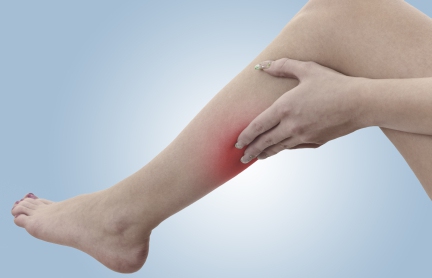The lower leg is vulnerable to pain and soreness mainly because the muscles here control foot motion and stability. It means slight change in footwear or activity may lead to issues like tendonitis. An increase in physical activity continues to be one of the leading causes of lower leg pain. However, many other health conditions may also cause pain in your leg or calf, and if it's accompanied by swelling, it's time to have it evaluated by your doctor.

What Causes Lower Leg Pain?
Cramps
A cramp can occur at night or while engaged in a sporting activity. Dehydration is usually the underlying issue here. Therefore, proper stretching and drinking fluids loaded with electrolytes may help relieve pain.
Muscle Strain or Fatigue
Muscle fatigue is as common as cramps, but increased activity is usually the culprit here. A muscle strain causes soreness that will go away by resting and using warm/cold compresses. It is important to confirm that it's only a muscle strain and not a muscle tear. Be sure to spend some time stretching prior to exercise to avoid muscle injuries that cause lower leg pain.
Blood Clots
Blood clots may well be the reason behind your lower leg pain. It is a common condition for hospitalized patients as well as for women who are on oral contraceptive medications. A person may find a blood clot developing in the calf after knee or hip surgery. A clot can sometimes block off blood vessels in your lung and create other complications too.
Pregnancy
Pregnant women will face certain issues with foot and leg, especially in their third trimester. Sore feet and legs are common complaints, triggered due to hormonal changes and an increase in the body weight. Sometimes, hormonal changes affect the arch of the feet leading to flat feet that puts excessive pressure on your leg muscles. This may result in soreness and pain in leg. Blood volume also changes in pregnancy, which may cause painful leg cramps.
Baker's Cyst
These cysts are common in people suffering from osteoarthritis. When they become large, they cause swelling and pain at the back of your leg. A cyst may rupture on its own and release its fluid to the calf muscles.
Vein Problems
When severe swelling (edema) and tenderness are present with leg pain, this could be due to a problem related to the veins of the legs that supply blood back to your heart. Venous insufficiency is one common vein problem, which can cause varicose veins, skin discoloration, and recurrent leg swelling. A DVT or Deep Vein Thrombosis is a less common, yet potentially life-threatening vein problem. It is basically a clot in one of your leg veins and may prove damaging for the lungs and other organs.
Peripheral Artery Disease (PAD)
It involves narrowing of one of your leg arteries that in turn restricts blood flow to the leg and causes severe lower leg pain. Vein problems will most likely produce warmth and redness in the leg, but PAD will lead to a cold, pale limb with increased sensitivity to pain. People who smoke, are diabetic, or have a history of heart disease are more at risk of developing PAD at some stage in life.
Achilles Tendonitis
Sometimes, the tendon that joins the back of the leg to the heel of your foot swells due to small tears and becomes painful near the bottom of your foot. The tendon is called the Achilles tendon, and the condition is known as Achilles tendonitis. The tendon is used for running, walking, and jumping, which is why Achilles tendonitis is a common occurrence in young athletes. If it's a full-blown rupture, it is impossible to walk on the foot.
Medical Conditions
Several medical conditions may produce leg pain. This may happen due to autoimmune disorders such as rheumatoid arthritis and multiple sclerosis. Fibromyalgia patients may suffer from restless leg syndrome and lower leg cramps. Similarly, thyroid disease may well be the reason why you're experiencing pain in your lower leg. Certain medications, including diuretics and statin drugs for managing cholesterol may cause leg pain and cramps.
Shin Splints
Running or jumping on hard surfaces will take a toll on the muscles along the edge of your shinbone. The repetitive force overloads tendons and leads to inflammation in connective tissues. The problem may hurt those people more who have flat feet or have extensive outward rotation of the foot. The pain usually subsides with rest.
Narrowed Spinal Canal (Stenosis) and Sciatica
Arthritis of the spine is the leading cause of a narrowed spinal canal, but a herniated disc may also compress nerve roots that produce symptoms of sciatica, such as numbness, weakness, tingling, fatigue, and cramping leg pain when sitting or standing. The pain usually originates from your hip and extends down into your leg.
When to See a Doctor
You should get in touch with your doctor if:
Your lower leg pain gets worse
You see swelling in both legs
You feel pain upon walking
You see varicose veins that are causing discomfort
You have a fever
Your leg is warm or cool to the touch
You experience breathing difficulties
You cannot put pressure on your leg
You experience a grinding or popping sound after an injury
How to Deal With Lower Leg Pain?
Your doctor will check your medical history and conduct a physical exam to diagnose the root cause of your lower leg pain. This may involve going for MRI, X-rays, or CT scan. An ultrasound is usually the preferred choice when your doctor suspects a blood clot in your lower leg.
Common treatment options include complete bed rest, elevation to reduce swelling, cold compresses, anti-inflammatory drugs and the use of crutches. Your doctor may also recommend physical therapy to help your leg regain its flexibility and strength.
Here's a video that will tell you more about lower leg pain and your treatment options:


View All Comments /Add Comment